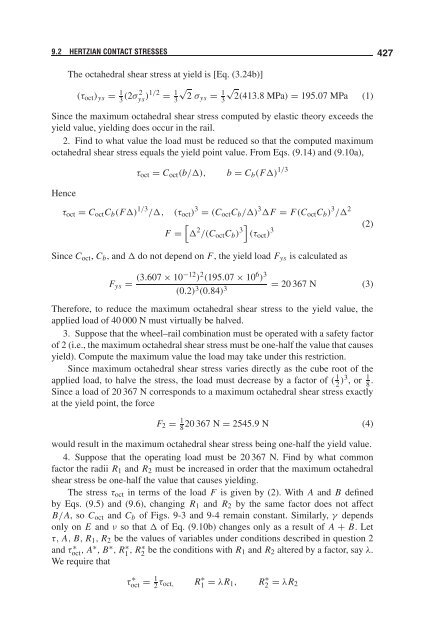9 Contact Stresses
9 Contact Stresses
9 Contact Stresses
Create successful ePaper yourself
Turn your PDF publications into a flip-book with our unique Google optimized e-Paper software.
9.2 HERTZIAN CONTACT STRESSES 427<br />
The octahedral shear stress at yield is [Eq. (3.24b)]<br />
√<br />
2(413.8MPa) = 195.07 MPa (1)<br />
(τoct)ys = 1 3 (2σ 2 ys )1/2 = 1 √<br />
3 2 σys = 1 3<br />
Since the maximum octahedral shear stress computed by elastic theory exceeds the<br />
yield value, yielding does occur in the rail.<br />
2. Find to what value the load must be reduced so that the computed maximum<br />
octahedral shear stress equals the yield point value. From Eqs. (9.14) and (9.10a),<br />
Hence<br />
τoct = Coct(b/), b = Cb(F) 1/3<br />
τoct = CoctCb(F) 1/3 /, (τoct) 3 = (CoctCb/) 3 F = F(CoctCb) 3 / 2<br />
<br />
F = 2 /(CoctCb) 3<br />
(τoct) 3<br />
Since Coct, Cb,and do not depend on F, the yield load Fys is calculated as<br />
Fys = (3.607 × 10−12 ) 2 (195.07 × 10 6 ) 3<br />
(0.2) 3 (0.84) 3<br />
(2)<br />
= 20 367 N (3)<br />
Therefore, to reduce the maximum octahedral shear stress to the yield value, the<br />
applied load of 40 000 N must virtually be halved.<br />
3. Suppose that the wheel–rail combination must be operated with a safety factor<br />
of 2 (i.e., the maximum octahedral shear stress must be one-half the value that causes<br />
yield). Compute the maximum value the load may take under this restriction.<br />
Since maximum octahedral shear stress varies directly as the cube root of the<br />
applied load, to halve the stress, the load must decrease by a factor of ( 1 2 )3 ,or 1 8 .<br />
Since a load of 20 367 N corresponds to a maximum octahedral shear stress exactly<br />
at the yield point, the force<br />
F2 = 1 820 367 N = 2545.9 N (4)<br />
would result in the maximum octahedral shear stress being one-half the yield value.<br />
4. Suppose that the operating load must be 20 367 N. Find by what common<br />
factor the radii R1 and R2 must be increased in order that the maximum octahedral<br />
shear stress be one-half the value that causes yielding.<br />
The stress τoct in terms of the load F is given by (2). With A and B defined<br />
by Eqs. (9.5) and (9.6), changing R1 and R2 by the same factor does not affect<br />
B/A, soCoct and Cb of Figs. 9-3 and 9-4 remain constant. Similarly, γ depends<br />
only on E and ν so that of Eq. (9.10b) changes only as a result of A + B. Let<br />
τ, A, B, R1, R2 be the values of variables under conditions described in question 2<br />
and τ ∗ oct , A∗ , B∗ , R∗ 1 , R∗ 2 be the conditions with R1 and R2 altered by a factor, say λ.<br />
We require that<br />
τ ∗ oct = 1 2 τoct, R ∗ 1 = λR1, R ∗ 2<br />
= λR2
















